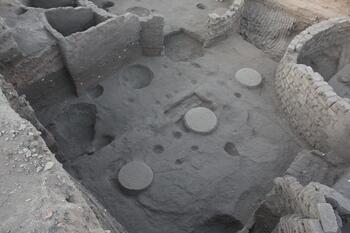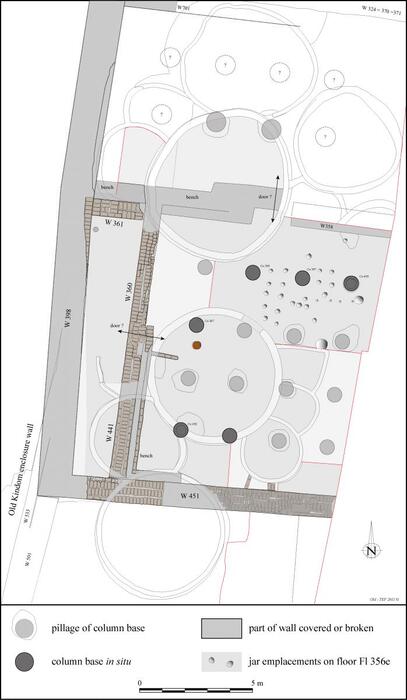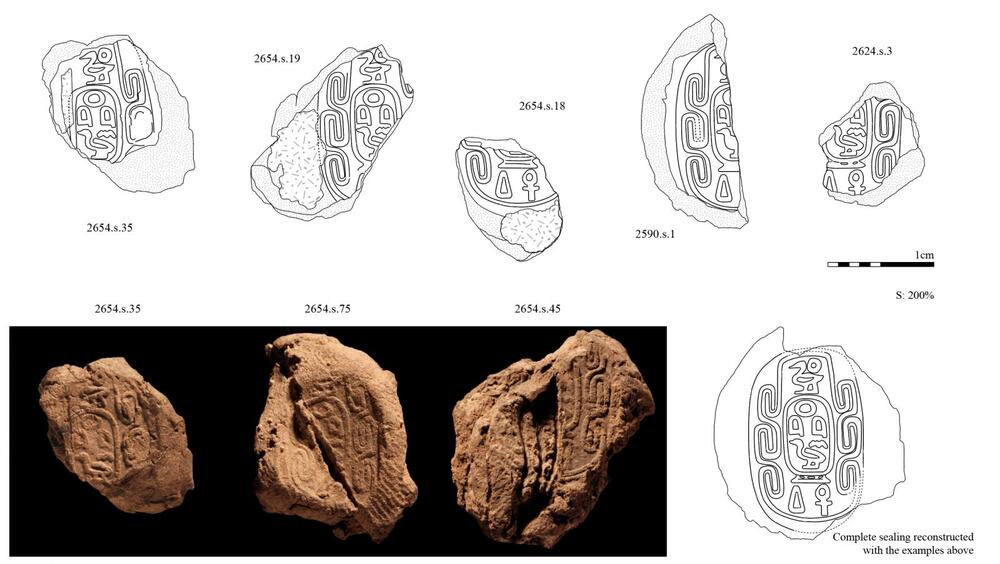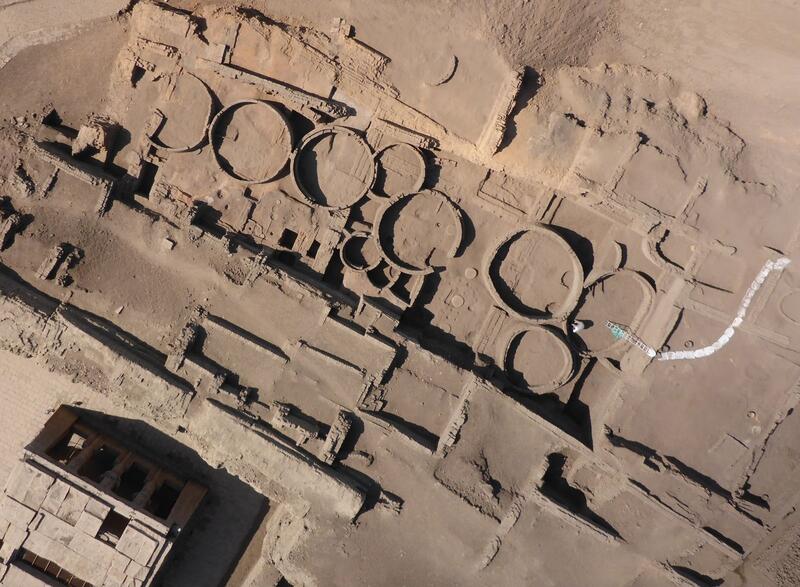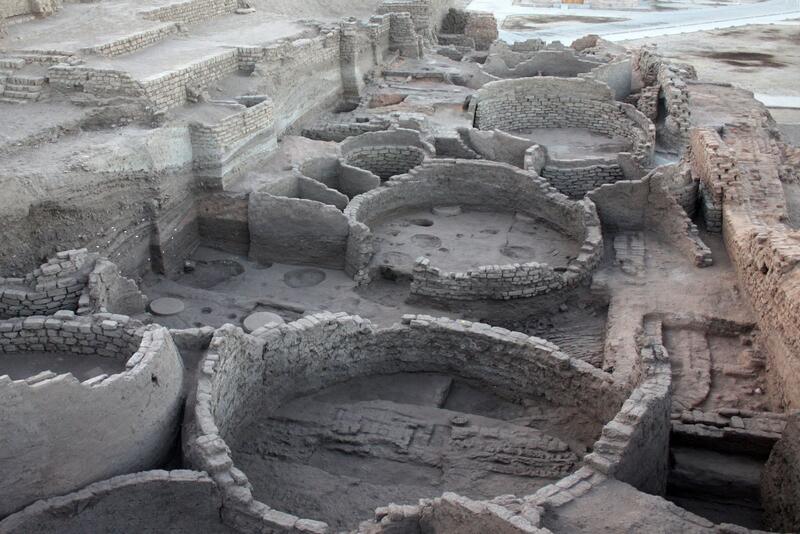The Governor’s Residence (Zone 1)
The Governor’s Residence (Zone 1)
What was likely the Governor’s Residence during the Middle Kingdom (Dynasties 11-14, 2055-1650 BCE) is situated on the eastern part of the tell along the inside of a large Ptolemaic enclosure wall. The official nature of the structure is suggested not only by its architecture and size, but also by the numerous seal impressions recovered within it. Over 1,400 clay sealings naming numerous kings such as Amenemhat III, Sobekhotep IV and Khayan, in addition to the names and titles of private officials such as the mayor of Edfu which provide evidence of large-scale administrative activity. The discovery of 41 seal impressions with the name of the Hyksos ruler Khayan (early Dynasty 15) has been particularly important as it has led to a reconsideration of the history of the early Second Intermediate Period (Dynasties 15-17, 1650-1550 BCE) and the contacts between the Hyksos kings in the north of Egypt and the Egyptians in Upper Egypt. The complex was abandoned and dismantled sometime between the latter half of Dynasty 13 and the early Second Intermediate Period.
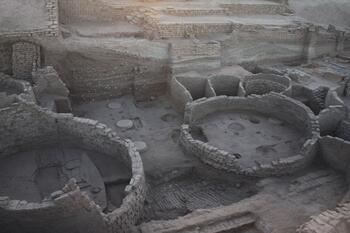 |
|
Fig. 11-12 - View of the southern columned hall of the Governor’s Residence with column bases in situ
Layout of the Governor’s Residence
This administrative complex contained two large columned halls and an elongated room to its west.
The southern columned hall measured roughly 9 by 12 meters and contained at least 16 octagonal wooden columns. Only some of the sandstone column bases have been preserved.
The full extent of the northern columned remains unclear, but at a minimum, it contained two rows of five columns and was the central feature of the building complex. Its limit to the north has not been reached yet because of later settlement remains covering the area.
Fig. 13 - Plan of the two columned halls of the Governor’s Residence
Objects from the Field: Seal Impressions
In ancient Egypt, letters, bags, jars, boxes, and doors were sealed using a lump of very fine clay, which was then stamped with a scarab seal naming the person or institution who closed it or to whom it belonged. Once the object was opened, the seal was broken and discarded. Seal impressions are important archaeological evidence for administrative activities, and they often carry with them a wealth of information. Their stylistic features of the decorative motives in addition to the occasional mention of royal names can help to date an archaeological context in conjunction with the ceramic evidence and other objects found in the same context. When they name an institution or officials, they can provide information about the function of the structure in which they were found. Their back sides can also retain the shape and texture of the object they had been sealing and provide information of the kind of commodities that had been received and opened.
Fig. 14 - Seal impressions with king Khayan’s name
Further readings:
- Moeller, Nadine and Marouard, Gregory. “The Context of the Khyan Sealings from Tell Edfu and Further Implications for the Second Intermediate Period in Upper Egypt.”, in: The Hyksos Ruler Khyan and the Early Second Intermediate Period in Egypt: Problems and Priorities of Current Research (…),Österreichische Akademie der Wissenschaften, Vienna, 2018, pp. 173-198.
- Moeller, Nadine and Marouard, Gregory. “Discussion of Late Middle Kingdom and Early Second Intermediate Period History and Chronology in Relation to the Khayan Sealings from Tell Edfu.” Egypt & Levant 21, 2011, pp. 87-121.
- Moeller, Nadine. “Unsealing Tell Edfu, Egypt: Who Was a Local Official and Who Was Not?” Near Eastern Archaeology 75/ 2, 2012, pp. 116-124.
The Silo Courtyard (Zone 1)
During Dynasty 17 (1580-1550 BCE, Second Intermediate Period), a large silo courtyard was constructed on top of the abandoned Governor’s Residence of the Middle Kingdom. Surrounded by a mudbrick enclosure wall, these round silos measure up to 6.5m in diameter and are the largest silos so far discovered within an ancient Egyptian city, and some could have hold up to around 35 tons of barley and 42 tons of wheat. Approximately 18 silos of different sizes have been identified so far. The silos held the grain reserve for the town until this storage facility fell out of use by the end of Dynasty 17- early Dynasty 18 (ca. 1550 BCE). After they had fallen out of use, the silos started being filled with large amounts of trash from the nearby settlement activity. In these trashes deposit all lot of interesting objects were discovered such as pot sherds (ostraca) inscribed with administrative notes and lists as well as various female figurines.
Fig. 15 - Kite view of the silo court at the end of the excavation
Fig. 16 - View of the silo court to the south (Zone 1)
Objects from the Field: Female Figurines
More than 60 female figurines have been discovered in the silo court. The vast majority of them were discarded in the area after it was abandoned during the late Dynasty 17 and early Dynasty 18. The exact function of these figurines remains unclear, but they seem to have been used in household rituals, as votive offerings for the birth of a child and the general health and fertility of the family. The two main types of statuettes recovered at Edfu were either tall figurines with flattened heads, or small rectangular plaques with schematic decorations. One of the most beautiful examples from Edfu is of a woman carrying a child on her back. 82 female figurines of the same types have also been found in the cemetery, in or in front of tombs dated to the Middle Kingdom (Dynasties 11-14, 2055-1650 BCE) and Second Intermediate Period (Dynasties 15-17, 1650-1550 BCE).
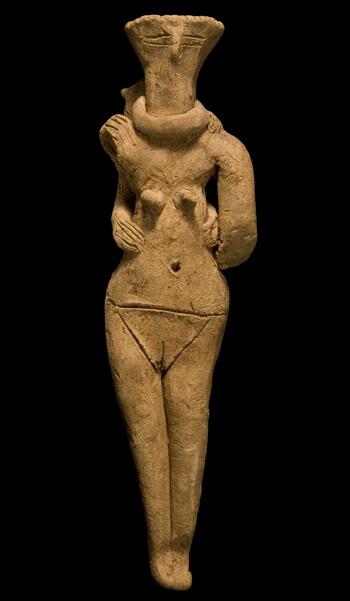 |
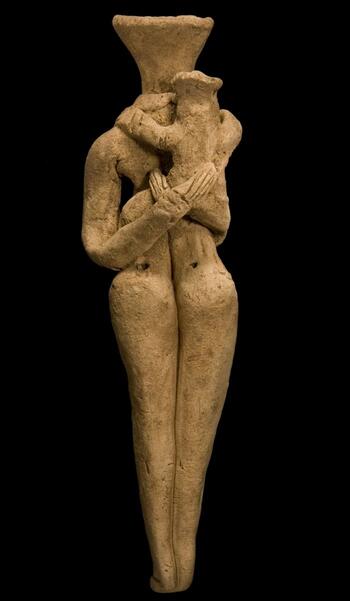 |
Fig. 17 - A female figurine made of fired clay, carrying a child on her back
Further readings:
- Moeller, Nadine. “Tell Edfu: Preliminary Report of Seasons 2005-2009.” Journal of the American Research Center in Egypt 46, 2010, pp. 81-111

